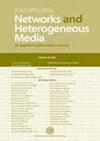在行为各异和受外部影响的不断增长的人口中,二元观点的扩散
IF 1.3
4区 数学
Q3 MATHEMATICS, INTERDISCIPLINARY APPLICATIONS
引用次数: 0
摘要
我们考虑一个不断增长的具有二元观点(即0或1)的个体群体,它们在离散时间内进化。底层交互网络已经完成。在每一个时间步,一个固定数量的个体被添加到种群中。新个体的意见可能取决于也可能不取决于当前人群的意见配置。此外,在每个时间步中,选择固定数量的个体,他们以三种可能的方式更新自己的观点:他们以一定的概率有机地改变自己的观点,并以一定的概率采用多数或少数观点。我们研究了具有任意一种意见的个体分数的渐近行为,并描述了它收敛到确定性极限的条件。我们分析了极限分数的行为,将其作为新个体持有意见1的概率的函数,以及与加入总体的人数与被选择更新意见的人数之比的函数。我们还讨论了极限分数周围波动的性质,并研究了随系统参数变化的尺度转换。此外,对于有限时间范围内的意见动态模型,我们根据何时影响以在有限时间范围结束时获得意见1的个体的最大期望分数,获得了最优的外部影响策略。本文章由计算机程序翻译,如有差异,请以英文原文为准。
Diffusion of binary opinions in a growing population with heterogeneous behaviour and external influence
We consider a growing population of individuals with binary opinions, namely, 0 or 1, that evolve in discrete time. The underlying interaction network is complete. At every time step, a fixed number of individuals are added to the population. The opinion of the new individuals may or may not depend on the current configuration of opinions in the population. Further, in each time step, a fixed number of individuals are chosen and they update their opinion in three possible ways: they organically switch their opinion with some probability and with some probability they adopt the majority or the minority opinion. We study the asymptotic behaviour of the fraction of individuals with either opinion and characterize conditions under which it converges to a deterministic limit. We analyze the behaviour of the limiting fraction as a function of the probability of new individuals having opinion 1 as well as with respect to the ratio of the number of people being added to the population and the number of people being chosen to update opinions. We also discuss the nature of fluctuations around the limiting fraction and study the transitions in scaling depending on the system parameters. Further, for this opinion dynamics model on a finite time horizon, we obtain optimal external influencing strategies in terms of when to influence to get the maximum expected fraction of individuals with opinion 1 at the end of the finite time horizon.
求助全文
通过发布文献求助,成功后即可免费获取论文全文。
去求助
来源期刊

Networks and Heterogeneous Media
数学-数学跨学科应用
CiteScore
1.80
自引率
0.00%
发文量
32
审稿时长
6-12 weeks
期刊介绍:
NHM offers a strong combination of three features: Interdisciplinary character, specific focus, and deep mathematical content. Also, the journal aims to create a link between the discrete and the continuous communities, which distinguishes it from other journals with strong PDE orientation.
NHM publishes original contributions of high quality in networks, heterogeneous media and related fields. NHM is thus devoted to research work on complex media arising in mathematical, physical, engineering, socio-economical and bio-medical problems.
 求助内容:
求助内容: 应助结果提醒方式:
应助结果提醒方式:


